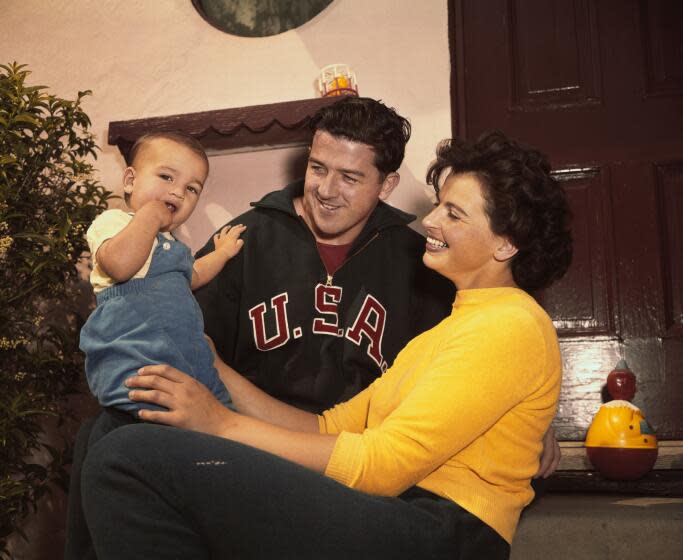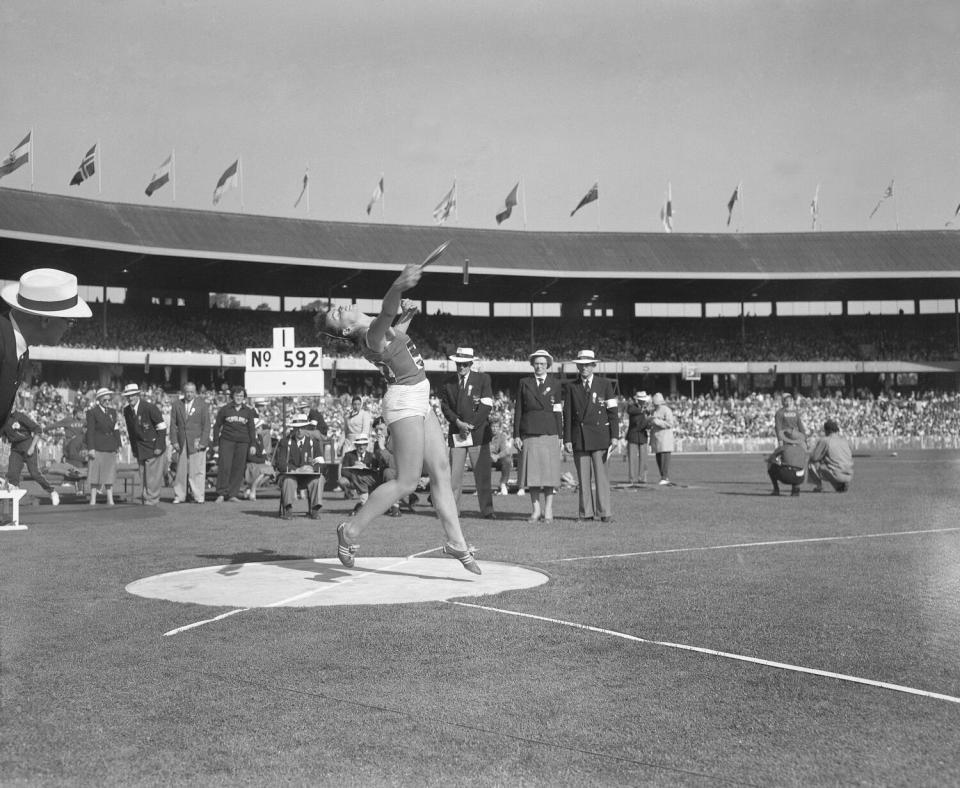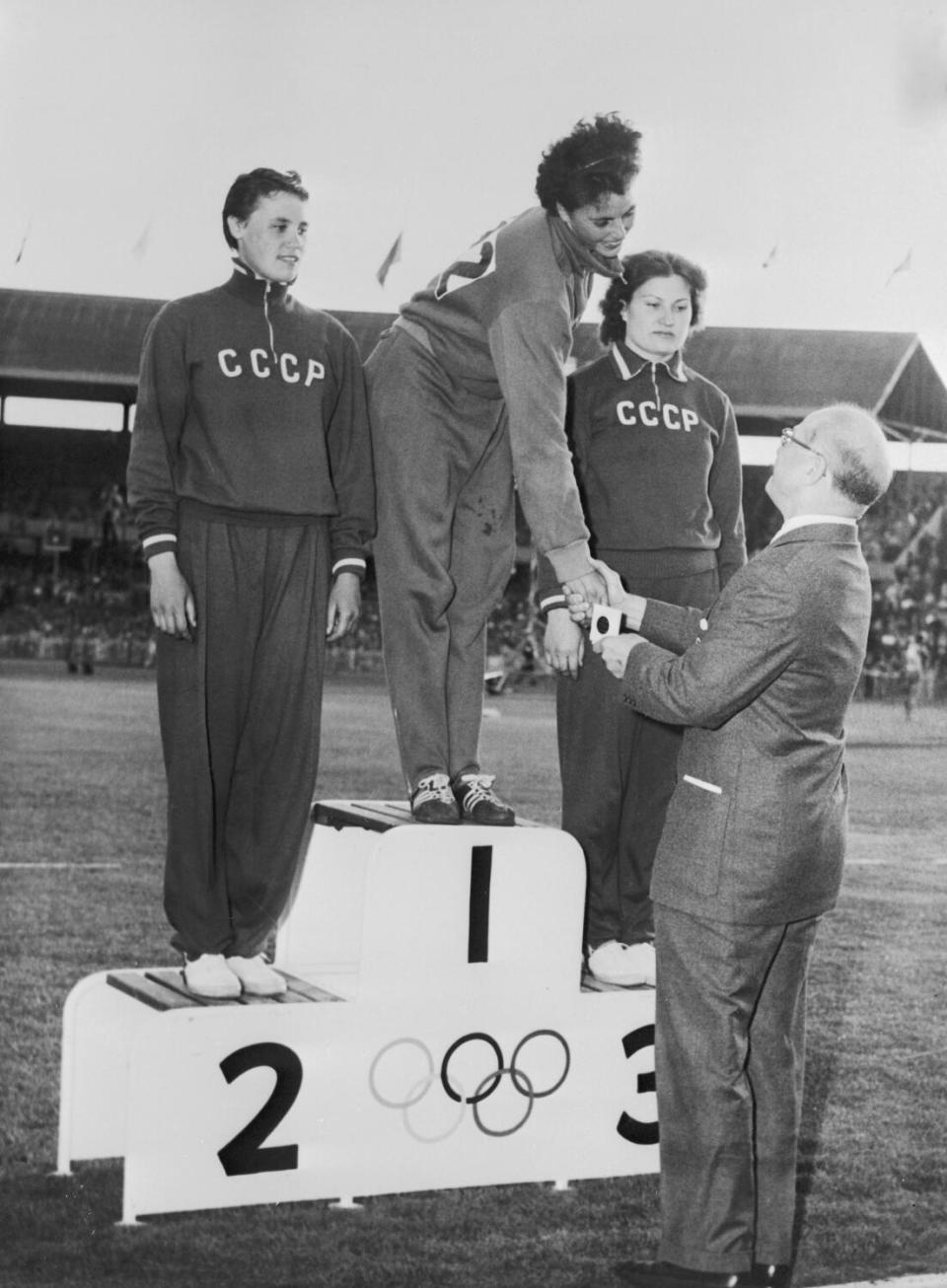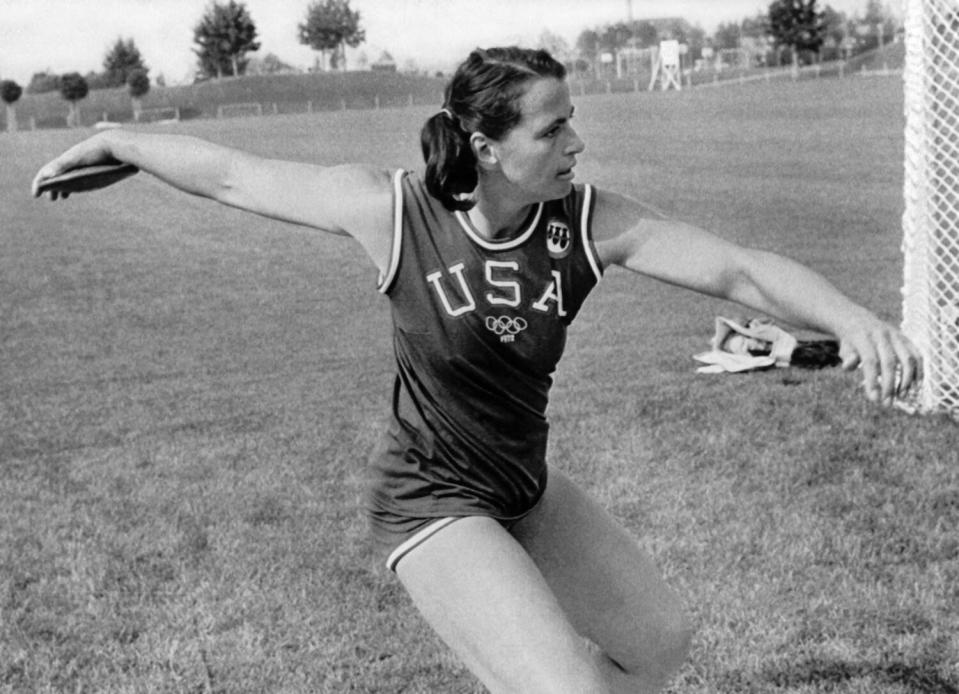Olga Fikotova Connolly didn't let East-West schism stop her Olympic-sized dreams

In a couple of months, we will be saturated with Olympic feel-good stories. That’s a big part of why television networks pay enormous sums for the rights to telecast the Games. They call these vignettes “up close and personal.” In many cases, “overdone and gooey” might be a better description.
Most likely, the Paris Olympics won’t create a yarn as good as the one about Olga Fikotova and Harold Connolly. There was nothing overdone and gooey about their story during the 1956 Games in Melbourne. It was the stuff of international headlines and worldwide emotion, and it is revisited here because Olga died April 12.
She was 91 and was preceded in death 14 years ago by Harold. Both spent much of their lives in and around Los Angeles.
Read more: Pat McCormick, Seal Beach diver who won Olympic gold in the 1950s, dies at 92
She was 23 when she made the five-day, multi-airplane trip to Australia. She was 5-foot-11 and 180 pounds, not the usual girth for an Olympian, male or female, in a throwing event. She was not among the favorites in the discus and had been a better athlete in basketball than track and field. A track coach had seen her athleticism and felt it would be best served as a discus thrower, despite her small build, and trained her as a rhythm thrower, not a muscle performer. For years, he had her toss the discus in practice to the background music of the Blue Danube Waltz. Rhythm, rhythm, rhythm.
In 1956, the Olympics were, among other things, an East-versus-West faceoff. Sadly, it was more than sports competition. Communist athletes and Western athletes were encouraged to stay separate and compete extra hard against one another. The famous “blood-on-the-water” water polo game between Hungary and the USSR capsulized the intensity of political and nationalistic emotion, even though both teams were part of the Soviet Bloc — Hungary not so willingly. Shortly before the match, the Soviet military had violently shut down the Hungarian Revolution. Emotions and anger poured over into the water polo game and when a Hungarian player left the pool with blood streaming down his face. The headline for the game was easy: Blood on the Water. Hungary won the game 4-0.
Olga’s Czechoslovakia was part of the Soviet bloc, but she was the only member of her team who had refused to sign on with the Communist party. In retrospect, that was classic Olga.

Once she got to Melbourne, Olga received much attention and technical help from better-known and bigger-medal prospects from Russia. They assumed she was one of them. Her discus competition was among the first in the Games, and when she got off her gold-medal toss of 176 feet and 1 inch, the Russians who had helped her, had to settle for the silver and bronze. Her winning toss was seven feet farther than her previous best.
She was celebrated in the Soviet bloc and it turned out that her gold was the only one taken in Melbourne by Czechoslovakia. She was a hero in her home country, until she wasn’t.
She told the story later about the immediate aftermath of her victory.
“I had a terrible blister on my foot and I had to compete in practice shoes,” she said. “Then, as soon as I was done competing, they took me off for surgery. My team went to the ocean in Australia, such a beautiful sight, and I had to sit on the beach while they went in the water. I had been told by my doctor to stay out of the water because of my foot. But as I sat there, an old man came up to me. I told him why I was sitting on the beach and not in the water. He said that was wrong and convinced me to go in. I did, and the next day, my foot was almost half healed.”
Somewhere between winning a gold medal, having surgery and going to the beach, Olga wandered into an equipment shed used by the discus, shot put, javelin and hammer competitors. Mingling with competitors from the West, especially male ones, was discouraged. But as would become evident soon, and for the rest of her life, Olga was never much of a click-her-heels and salute person.
So, there she was, in the equipment shed, and there was this husky American, Harold Connolly. And the rest became history, an Olympic story of Olympic proportions.

They fell in love. Harold won the hammer throw the day after Olga’s discus triumph, so they each had a gold medal and time on their hands. They danced the nights away in an Olympic Village where East and West mingling was discouraged and was mostly ignored by 20- to 25-year-olds. Somehow, worlds apart, they communicated, according to Olga “with my fragmented English and Harold’s fragmented German.”
There were pictures and stories and the whole world soon knew. The official stance in Czechoslovakia was that Olga had brought “50% honor to her country and 50% shame for taking up with “an American Facist.”
Harold proposed, Olga wished to get married in her home country and permission was granted when Czech Olympic legends Emil Zatopek and his wife, Dana Zatopkova, were listed as wedding witnesses. Zatopek had won three gold medals in distance races and Zatopkova had won agold in javelin, as well as many European competitions. Nobody said no to that superstar pair.
Olga had hoped for a small wedding in the Old Town Square in Prague. En route, her car was slowed many times and she thought there had been an accident. When she finally arrived, the center of Prague was packed. Estimates ran from 25,000 to 40,000 people, there to see her marry the handsome “American Facist.” Olympic columnist Randy Harvey, in an L.A. Times story in 1989, cited a New York Times’ editorial the day after the wedding, that read: “The H-Bomb overhangs us like a cloud of doom. The subway during rush hour is almost impossible to endure. But Olga and Harold are in love, and the world does not say no to them.”
The Connollys were immensely popular and immensely poor. After the wedding, Harold sold his hammer-throwing equipment to earn them enough to fly home. When they landed in Boston, near Harold’s home, they had 35 cents to their name and jobs were crucial. For a while, Olga cleaned the offices at the Boston Globe.
They eventually moved to Southern California. Olga, who had wanted to continue to compete for her home country, was not allowed to and ended up making four more Olympic teams for the United States. In her last Olympics, the Munich Games in 1972, she was elected to carry the flag at opening ceremonies. The U.S. team officials didn’t like that choice. Olga had been very clear and typically very loud about her anti-Vietnam War sentiments. The team officials asked for another team vote. The result was the same. Olga led the U.S. team into the stadium. Afterward, one of the U.S. officials praised her for the way she led her team in.
“I learned how to march in Czechoslovakia,” she replied, sarcastically.

Olga and Harold were married for 17 years. They had four children, Jimmy, Merja, Nina and Mark. Jimmy was a national college decathlon champion, Merja a world-class volleyball player and Mark a Golden Gloves boxer in Las Vegas. After Olga and Harold divorced, Olga told Harvey in a Times article that what they had as a couple was wonderful, but maybe not true love. She had wanted to move on. Harold set nine more world records in the hammer throw after they were married. They remained good friends and she stayed cordial with Harold’s new wife, Pat Daniels, who participated in three Olympics herself and became, as Pat Connolly, sprinter Evelyn Ashford’s coach.
Olga championed, many causes around Los Angeles. She was an advocate for fitness and proper nutrition. She worked for a time at a home for the elderly. She fought for literacy programs and wrote many letters to The Times, seeking publication after marching into the sports editor’s office to discuss her views. She was opinionated, sometimes off-putting, but never lacking passion or empathy.
She was fond of calling Melbourne “My Olympics,” and said, “All that was on my mind was to do something good for the Czech people. I wanted to do it for the streetcar driver who told me I didn’t have to pay when I got on, or the man at the newsstand who gave me a paper in the morning and said I didn’t have to pay.”
In her later years, Olga joked about what the Olympics had become. She laughed and said that the Games started in Greece with everybody training and competing naked, so that everybody was equal. “Now, they make everybody go through metal detectors.”
If TV tells the story of Olga Connolly this summer, it probably won’t use that quote.
This story originally appeared in Los Angeles Times.

